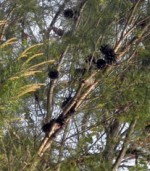 Sand pine is a coniferous shrubby tree native to areas in Florida, Georgia, and Alabama where it grows in the infertile very well-drained soils of ridges, barrens, and dunes. It is a member of the pine family, Pinaceae, the largest extant conifer family in species diversity that also includes firs, hemlocks, cedars, larches and spruces. The plants have relatively smooth bark when young but develop a plate-like look with age. The needles are up to 4 inches long and occur in pairs. The cones are up to 3.5 inches long and are of two types; one has a wax coating that melts only when exposed to fire that kills the mother tree, the other lacks a waxy coat and disperses seeds without needing fire to open them. The cones often become embedded in the wood. The trees are suitable for screens or a windbreak in hot sunny areas with harsh conditions including salt spray and are used in parking lots and highway strips where most other trees can not survive. They are also valued as Christmas trees and are a valuable source of wood pulp.
Sand pine is a coniferous shrubby tree native to areas in Florida, Georgia, and Alabama where it grows in the infertile very well-drained soils of ridges, barrens, and dunes. It is a member of the pine family, Pinaceae, the largest extant conifer family in species diversity that also includes firs, hemlocks, cedars, larches and spruces. The plants have relatively smooth bark when young but develop a plate-like look with age. The needles are up to 4 inches long and occur in pairs. The cones are up to 3.5 inches long and are of two types; one has a wax coating that melts only when exposed to fire that kills the mother tree, the other lacks a waxy coat and disperses seeds without needing fire to open them. The cones often become embedded in the wood. The trees are suitable for screens or a windbreak in hot sunny areas with harsh conditions including salt spray and are used in parking lots and highway strips where most other trees can not survive. They are also valued as Christmas trees and are a valuable source of wood pulp.
Type: Coniferous shrubby tree
Outstanding Feature: Tolerance to harsh conditions
Form: Upright to mounding with oval open canopy
Growth Rate: Slow to rapid depending on moisture
Bloom: N/A
Size: 30-40’ H x 10-15’ W
Light: Full sun but tolerates part shade
Soil: Infertile to average, dry to medium moist, very well-drained; tolerates drought
Hardiness: Zones 7-9
Care: Low maintenance; does not require pruning to develop good structure.
Pests and Diseases: None of significance
Propagation: Seed